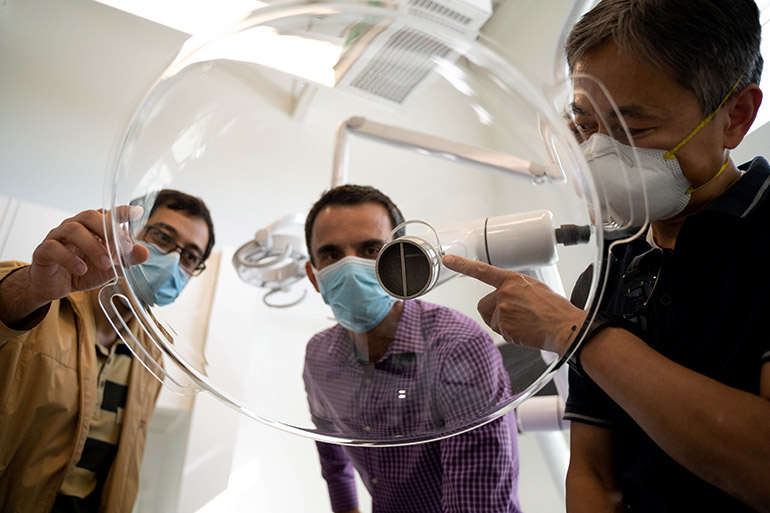New device aims to isolate and remove droplets and airborne viruses
UBC Okanagan researchers are collaborating with Kelowna-based Care Health Meditech to develop a new device that isolates and eliminates airborne droplets and germs associated with COVID-19 and other illnesses.
With operating principles similar to a vacuum hood, the Airborne Infection Isolation and Removal (AIIR) device is initially targeted at the dental industry to improve the safety of both staff and patients. Many dental procedures generate aerosols, or small droplets of saliva and blood, that are ejected into the air. These aerosols float in the room and can contain dangerous particles that contain viruses like SARS-COV2, influenza, tuberculosis, HPV and aerosolized mercury, explains Care Health Meditech Managing Partner Stephen Munro.
“To aid in the development of AIIR, we turned to UBC researchers for their expertise in multiphase flows and computational fluid dynamics which will help evolve the design ensuring its effectiveness,” Munro says.
Transmission of the COVID-19 virus is thought to occur through breathing in respiratory droplets, touching contaminated surfaces or inhaling particles in the air. According to Munro, the key to controlling the transmission is to isolate and eliminate COVID-19 contaminated air and droplets, particularly aerosols.
While the AIIR device is currently being used by some dentists, UBCO researchers are now looking at ways to improve the design through computational fluid dynamics simulation and specific testing in Associate Professor Sunny Li’s Thermal Management and Multiphase Flows lab.
“Our team is looking at the device’s size and geometry in connection with its airflow dynamics and the dynamics of droplets and particles to make it more accurate and efficient,” says Li, who teaches multiphase flows and is one of the lead researchers on the project.
Li is working with Assistant Professors Joshua Brinkerhoff and Sina Kheirkhah from the School of Engineering, and Associate Professor Jonathan Little from the School of Health and Exercise Sciences to provide design modifications and recommendations.
During testing, dental procedures will be mimicked in the lab with a dental mannequin connected to a breathing simulator. Particle Imaging Velocimetry and High-speed Shadow Photography Imaging will be used to visualize airflow and track the motion of all droplets. Droplet motion and trajectory can vary depending on the droplet size and local airflow, explains Li.
While work is being done in the labs to optimize and improve the device for frontline acute healthcare settings, due to high demand Care Health Meditech’s initial AIIR device is already being delivered to dentists in both Canada and the USA.
“Although we are targeting the dental industry, there’s an opportunity to expand into other areas where the risk of airborne infection is high,” says Munro, adding his company has already developed in-house manufacturing capabilities for the device.
“The AIIR has the potential to reduce the risk of patients and dentists being exposed to the COVID-19 virus, and will allow dentistry to return to near-normal procedures,” says Munro. “This is significant for Canada and the world as it reduces the need for production and the purchase of personal protection equipment (PPE) and in a few years we aim to have the potential to reduce the need for PPE and N95 respirators for routine procedures in hospitals, doctor’s offices and care facilities.”
The research is funded by a Mitacs Accelerate Grant.

UBC Associate Professor Sunny Li, right, discusses adaptations to the Airborne Infection Isolation and Removal system, with his doctoral student Mojtaba Zabihi and Care Health Meditech Managing Partner Stephen Munro, centre.
About UBC's Okanagan campus
UBC’s Okanagan campus is an innovative hub for research and learning founded in 2005 in partnership with local Indigenous peoples, the Syilx Okanagan Nation, in whose territory the campus resides. As part of UBC—ranked among the world’s top 20 public universities—the Okanagan campus combines a globally recognized UBC education with a tight-knit and entrepreneurial community that welcomes students and faculty from around the world in British Columbia’s stunning Okanagan Valley.
To find out more, visit: ok.ubc.ca
 Suit claims prison assaults
Suit claims prison assaults Pair facing drug charges
Pair facing drug charges 'Eat the rich' vandals strike
'Eat the rich' vandals strike Searching landfill for woman
Searching landfill for woman Poland urges more spending
Poland urges more spending Cutting rates at own pace
Cutting rates at own pace Israeli strike played down
Israeli strike played down Full Trump jury seated
Full Trump jury seated World's largest election
World's largest election  Investigating pipeline blast
Investigating pipeline blast TikTok testing new app
TikTok testing new app Body Shop explores sale
Body Shop explores sale Warriors ready for Round 2
Warriors ready for Round 2 Kalamalka Bowl cancelled
Kalamalka Bowl cancelled Rockets live to fight on
Rockets live to fight on Hilton teams up with Sia
Hilton teams up with Sia Swift still 'can't forgive' Kim
Swift still 'can't forgive' Kim Grimes to ‘cap the disarray’
Grimes to ‘cap the disarray’


